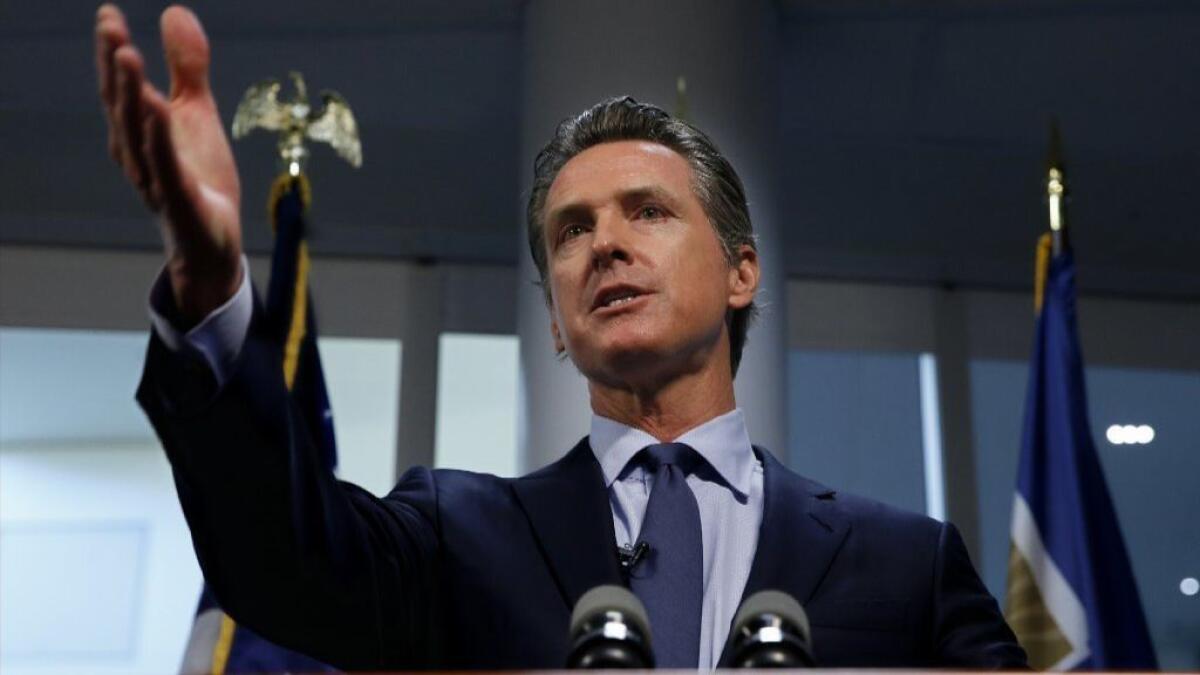California hits back as Trump threatens to ‘dump’ immigrants in ‘sanctuary cities’

California Democrats this week stepped up their attacks on President Trump over his threat to send immigrants to so-called sanctuary cities, even as experts suggested the president’s plan could backfire and lure more migrants to the north.
Gov. Gavin Newsom labeled the president’s proposed policy nonsensical, saying Trump campaigned on deporting more immigrants. But his latest plan looks as if he intends to allow some migrants to remain in the U.S.
“Which one is it, Mr. President?” Newsom asked rhetorically, in an interview with The Times. “That fundamental flaw in the logic needs to be considered.”
The governor insisted the federal government is already “dumping people” in California by processing migrants legally seeking asylum at the border and releasing them into California before they have time to connect with their sponsors in the U.S.
Several mayors also reacted. L.A. Mayor Eric Garcetti tweeted that immigrants “are people, not pawns,” Oakland Mayor Libby Schaaf told Trump to stop fanning “hate and division,” and San Jose Mayor Sam Liccardo called for “sensible solutions.”
L.A. County Supervisor Hilda Solis also said in a statement that “the only way to address immigration in this country is through bipartisan comprehensive immigration reform.”
The back-and-forth marked the latest exchange between Trump and his favorite West Coast target.
On Monday, Trump doubled down on his threat to send immigrants to “sanctuary cities,” a proposal first revealed by the Washington Post. He tweeted that “illegal immigrants who can no longer be legally held (Congress must fix the laws and loopholes) will be, subject to Homeland Security, given to sanctuary cities and states!”
Trump’s own aides have told him that such a policy on releasing migrants would likely be illegal and unfeasible — an assessment backed by former immigration officials and legal experts.
Officials with the U.S. Department of Homeland Security did not respond to requests for comment from The Times about whether they were making plans to implement the president’s proposed policy.
It’s unclear what authority, if any, the administration would have to bus migrants from detention centers near the border and release them into sanctuary cities and other Democratic strongholds broadly opposed to Trump’s efforts to crack down on immigration.
Following the passage of Senate Bill 54, the law signed by former Gov. Jerry Brown that limited cooperation between local law enforcement agencies and federal immigration agents, the Trump administration sued California to nullify it and two other laws designed to protect immigrants in the country illegally.
At least seven federal courts have ruled previous attempts by the Trump administration to cut off federal funding to cities and states, including California, for resisting cooperation with immigration authorities as unlawful. The U.S. Supreme Court also has ruled on several occasions that the federal government can’t coerce states and cities into helping it implement federal immigration policies.
The president has grown increasingly frustrated that, more than two years into his administration, his policies have failed to deter migrants from reaching the border or, for the most part, prevent their release from detention once inside the United States. Last month, U.S. authorities apprehended 92,607 people at the border, the highest monthly total in more than a decade.
Last week, Trump ousted a slew of his top officials in Homeland Security, in part because of their opposition to such proposals as releasing migrants into cities and states whose representatives the president sees as political enemies.
Roberto Suro, a professor of public policy at USC, called Trump’s latest plan an “ill-informed and self-defeating idea.”
There is no clear definition of a “sanctuary” city or state, but in general, jurisdictions that adopt the designation vow to offer political support or practical protection to people who are in the country illegally.
The term dates to the 1980s, when Berkeley and a few other municipalities declared themselves as such to accept migrants from Central America. At the time, U.S. immigration policies allowed some Central Americans, but not others, to enter the country.
Many sanctuary cities are big metropolitan areas that are accustomed to receiving newcomers, and have policies in place intended to help resettle asylum seekers while their cases are pending, Suro said.
For instance, California law provides a number of benefits for people without legal status, including healthcare and driver’s licenses. The state’s cities have robust immigrant rights organizations and an existing infrastructure to provide legal assistance for immigrants and asylum seekers.
“And, in a whooping irony, these metros are exactly the destinations that many, probably most, asylum seekers want to reach. These are the places where their kin and compatriots are concentrated,” Suro said. “Tell a Central American asylum seeker that her punishment is being sent to Los Angeles, and she might well say a prayer of thanks.”
OPINION: Trump’s plan to release detained immigrants in ‘sanctuary cities’ won’t stand. Here’s why »
Trump and California Democrats are appealing to their respective political bases by attacking one another. But posturing on both sides doesn’t serve anyone well, said Louis DeSipio, a professor of political science at UC Irvine.
“The rhetorical battles — in particular, President Trump’s threats — are supposed to antagonize and aren’t an effort to construct a solution to what is a challenge at the southern border,” he said.
David Dorsen, a public policy expert and legal scholar based in Washington, D.C., said Trump’s threat to send migrants to sanctuary cities is a problem even if it doesn’t become a reality because it might entice more people to make the treacherous trip north.
“They’ll say ‘This is a new way of coming to the United States. Let’s go.’”
Staff writers Noah Bierman and Laura King contributed to this report.
Twitter: @dakotacdsmith
More to Read
Sign up for Essential California
The most important California stories and recommendations in your inbox every morning.
You may occasionally receive promotional content from the Los Angeles Times.














